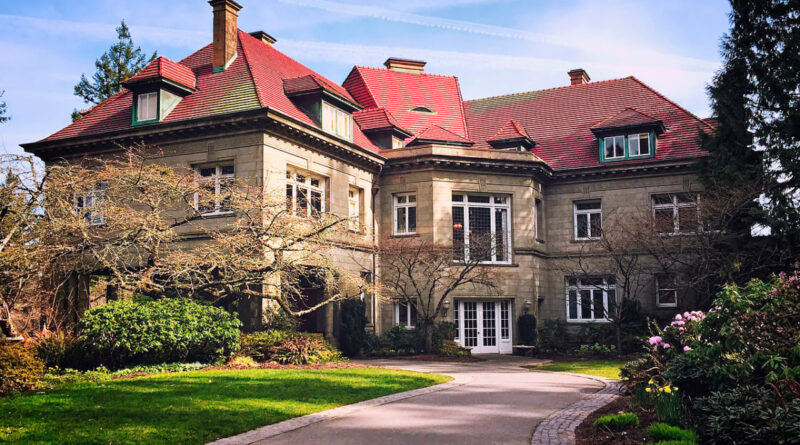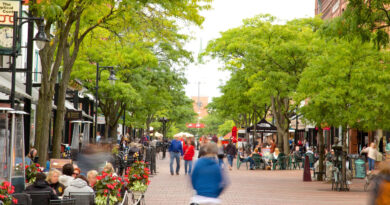Pittock Mansion in Portland Oregon
Perched high in the West Hills of Portland, Oregon, Pittock Mansion stands as a testament to the city’s rich history and the legacy of one of its most influential families. This French Renaissance-style mansion, completed in 1914, offers visitors a glimpse into the opulent lifestyle of early 20th-century Portland, as well as breathtaking panoramic views of the city and the Cascade Mountains. The mansion’s architectural grandeur, historical significance, and picturesque setting make it a must-visit destination for anyone interested in the history and culture of the Pacific Northwest.
History of Pittock Mansion
Pittock Mansion was built by Henry Pittock, a pioneer, businessman, and publisher, and his wife, Georgiana Burton Pittock. Henry Pittock was an English immigrant who arrived in Oregon in 1853. He initially worked as a typesetter for The Oregonian, a small, struggling newspaper at the time. Through hard work and determination, Pittock eventually took over the newspaper in 1860, transforming it into one of the most successful publications in the Pacific Northwest.
In addition to his publishing success, Henry Pittock was involved in various business ventures, including real estate, banking, railroads, and the timber industry. His entrepreneurial spirit and keen business acumen helped shape Portland’s economic landscape.
Georgiana Pittock was equally influential, known for her philanthropic efforts and active involvement in community affairs. She was instrumental in establishing several civic organizations, including the Portland Rose Society, which played a significant role in earning Portland its nickname, the “City of Roses.”
The Pittocks began construction of their dream home in 1912, choosing a 46-acre site with commanding views of the city and mountains. Designed by architect Edward Foulkes, the mansion was completed in 1914. Unfortunately, both Henry and Georgiana enjoyed their new home for only a few years before passing away in 1918 and 1919, respectively.
Architectural Features
Pittock Mansion is an architectural masterpiece that reflects the elegance and opulence of the early 20th century. The 16,000-square-foot mansion features 46 rooms, including a library, music room, Turkish smoking room, and multiple bedrooms and bathrooms.
1. Exterior Design: The mansion’s exterior is a blend of French Renaissance and Victorian styles, featuring sandstone walls, a red-tiled roof, and ornate detailing. The expansive grounds include beautifully landscaped gardens, which add to the estate’s grandeur.
2. Interior Design: The interior of Pittock Mansion showcases exquisite craftsmanship and luxurious materials. The grand staircase, made of white oak, is a focal point of the mansion, leading visitors to the upper floors. The mansion also features elaborate woodwork, intricate plaster ceilings, and imported marble.
3. Modern Innovations: Despite its historical charm, Pittock Mansion was equipped with several modern amenities for its time. These included a central vacuum system, intercoms, indirect lighting, and a sophisticated internal heating system, reflecting Henry Pittock’s interest in innovative technologies.
The Pittock Family Legacy
The legacy of Henry and Georgiana Pittock extends beyond the mansion itself. The Pittocks were prominent figures in Portland’s development and made lasting contributions to the city’s cultural and economic growth.
1. Philanthropy: Georgiana Pittock’s philanthropic efforts included support for the Portland Rose Festival, the Ladies Relief Society, and the construction of various churches and schools. Her commitment to community service left a lasting impact on Portland’s civic life.
2. Business Ventures: Henry Pittock’s business ventures helped shape Portland’s economic landscape. In addition to his success with The Oregonian, he was involved in banking, real estate, and the timber industry, contributing to the city’s growth and prosperity.
The Mansion’s Transition to a Museum
After the deaths of Henry and Georgiana Pittock, the mansion remained in the family until the late 1950s. In 1958, the estate was sold to private owners, who planned to develop the property. However, a series of severe storms in 1962 caused extensive damage to the mansion, leaving it in disrepair.
Recognizing the historical and cultural significance of Pittock Mansion, the community rallied to save it. In 1964, the City of Portland purchased the property, and extensive restoration efforts were undertaken to return the mansion to its former glory. In 1965, Pittock Mansion was opened to the public as a museum, allowing visitors to explore its rich history and architectural beauty.
Visiting Pittock Mansion
Today, Pittock Mansion is a popular tourist attraction and a window into Portland’s past. Visitors can take guided tours of the mansion, exploring its many rooms and learning about the lives of the Pittock family and the history of Portland.
1. Exhibits and Events: The mansion features permanent and rotating exhibits that provide insight into the early 20th-century lifestyle, the Pittock family’s contributions to Portland, and the architectural features of the mansion. Special events, including holiday celebrations and educational programs, are also held throughout the year.
2. Scenic Views: One of the highlights of visiting Pittock Mansion is the stunning view from the estate. On clear days, visitors can enjoy panoramic views of downtown Portland, Mount Hood, Mount St. Helens, and other peaks in the Cascade Range.
3. Gardens and Trails: The mansion is surrounded by beautifully maintained gardens and is adjacent to several hiking trails in Forest Park. These trails offer a wonderful opportunity to explore Portland’s natural beauty and enjoy a peaceful walk in the woods.
Conclusion
Pittock Mansion stands as a symbol of Portland’s rich history, architectural grandeur, and the enduring legacy of the Pittock family. Whether you are a history buff, an architecture enthusiast, or simply someone who appreciates stunning views and beautiful gardens, Pittock Mansion offers a unique and enriching experience. As a preserved piece of Portland’s heritage, it continues to educate and inspire visitors from around the world.
Discover more from City Towner
Subscribe to get the latest posts sent to your email.




